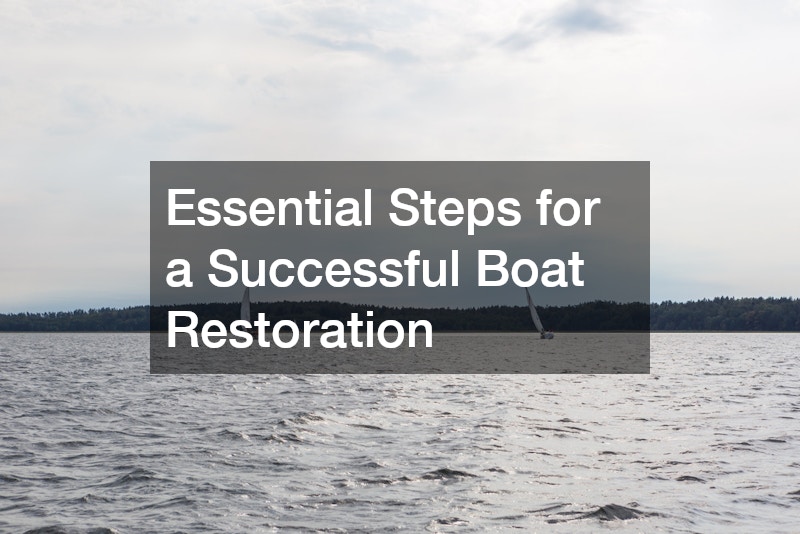
Boat restoration can be a rewarding project that revitalizes an old vessel and gives it new life. Whether driven by nostalgia, love for the sea, or simply the thrill of a challenge, restoring a boat requires a clear understanding of essential steps, careful planning, and attention to detail. This article will guide you through the process, defining crucial stages and answering common questions to ensure a successful restoration.
What Are the Initial Steps to Start a Boat Restoration Project?
Assessing the Boat’s Condition
Understanding the current state of your boat is critical. Begin with a thorough inspection to identify major repairs, structural integrity, and potential hazards. This step ensures that you are aware of what lies ahead and allows for informed decision-making.
Delve into the details by examining the hull, rigging, and deck for damage or weaknesses. It’s essential to check for areas prone to rot, cracks, or other wear that might compromise the boat’s safety. Adequately assessing these components can save you time and resources in the long run.
Additionally, document any findings with notes or photographs. This will help in creating a detailed restoration plan and serve as a benchmark for tracking progress. An accurate assessment is the foundation of every successful restoration project.
Establishing a Restoration Plan
Create a comprehensive plan outlining the scope of work, budget, timeline, and resources. This will serve as your roadmap throughout the restoration process. A well-structured plan not only keeps the project organized but also helps in anticipating potential challenges.
Your plan should include a prioritized list of tasks to ensure that essential repairs are completed first. Breaking down the project into manageable steps helps in maintaining focus and ensures that important details are not overlooked. Detailed planning also helps in avoiding unnecessary expenses by buying only what is needed at each stage.
Research is crucial at this phase to understand what materials and skills you’ll need. Engaging in forums or communities can provide valuable insights and advice from experienced restorers. A thorough plan minimizes risks and enhances the efficiency of your restoration project.
Gathering Necessary Tools and Materials
Assemble the required tools and materials before beginning the restoration to avoid delays. This includes specialized equipment, replacement parts, and safety gear. Having all necessary items on hand ensures that work progresses smoothly and efficiently.
Make a checklist to track tools such as sanders, drills, and brushes, and ensure that you have all protective gear like gloves and goggles. Replacing outdated engine parts and electronics ahead of time can prevent mid-project interruptions. Consider sourcing high-quality materials for better longevity and performance.
Building a relationship with suppliers ensures a steady supply of parts and advice. Engaging with a knowledgeable vendor can be invaluable, especially when sourcing hard-to-find parts. Preparation is key to avoiding unforeseen expenses and time-consuming detours.
How Do I Prioritize Tasks During the Restoration Process?
Addressing Structural Repairs First
Focus on structural components such as the hull, deck, and transom. Fixing any structural issues ensures a safe and stable foundation for additional work. This phase is crucial in maintaining the vessel’s integrity and seaworthiness.
Structural repairs should be approached meticulously, using quality materials and professional techniques. Neglecting even minor structural flaws can lead to significant complications later on. By achieving a solid foundation, subsequent phases of the restoration can be approached with confidence.
Consulting a marine surveyor can be beneficial in assessing and planning structural repairs. Their expertise can provide peace of mind and assurance of compliance with safety standards. Properly addressing these issues transforms your vessel into a reliable and safe craft.
Restoring the Engine and Electrical Systems
Once the structure is sound, concentrate on mechanical and electrical systems. Perform necessary engine repairs, replace wiring, and ensure safety features are functional. This step is pivotal in transforming a stationary vessel into a fully operational one.
Regularly test your engine and electrical components during restoration. Implement a battery management system to streamline operations and maintain efficiency. Investing time in these systems serves as the backbone of your boat’s function and longevity.
Replacing outdated navigation and lighting systems contributes significantly to safety and convenience. Modern technology can offer improved performance and reliability. With these improvements, your boat becomes a vessel ready to undertake new adventures.
Successfully restoring a boat is a multifaceted endeavor that balances practicality and aesthetics. By following a structured approach, addressing key concerns, and prioritizing tasks effectively, anyone can transform a neglected vessel into a seaworthy beauty. Remember, patience and dedication are your greatest allies on this journey.
.




